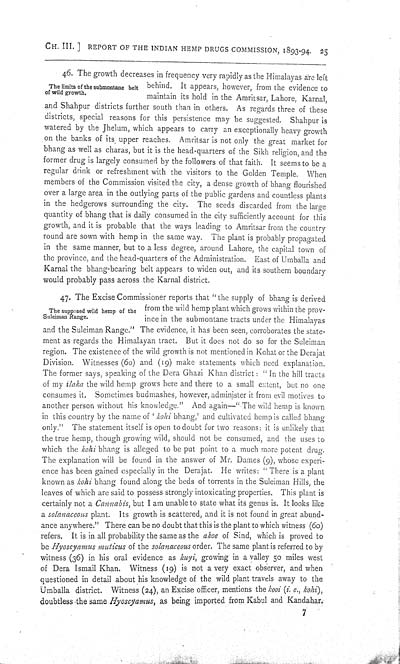Download files
Individual page:
Thumbnail gallery: Grid view | List view

CH. III.] REPORT OF THE INDIAN HEMP DRUGS COMMISSION, 1893-94. 25
The limits of the
submontane belt
of wild growth.
46. The growth decreases
in frequency very rapidly as the Himalayas are left
behind. It appears, however,
from the evidence to
maintain its hold in the Amritsar, Lahore, Karnal,
and Shahpur districts
further south than in others. As regards three of these
districts, special reasons for this persistence may be suggested.
Shahpur is
watered by the Jhelum, which appears to carry an exceptionally
heavy growth
on the banks of its upper reaches. Amritsar is not only the great
market for
bhang as well as charas, but it is the head-quarters of the Sikh
religion, and the
former drug is largely consumed by the followers of that faith. It
seems to be a
regular drink or refreshment with the visitors to the Golden
Temple. When
members of the Commission visited the city, a dense growth of bhang
flourished
over a large area in the outlying parts of the public gardens and
countless plants
in the hedgerows surrounding the city. The seeds discarded from the
large
quantity of bhang that is daily consumed in the city sufficiently
account for this
growth, and it is probable that the ways leading to Amritsar from
the country
round are sown with hemp in the same way. The plant is probably
propagated
in the same manner, but to a less degree, around Lahore, the
capital town of
the province, and the head-quarters of the Administration. East of
Umballa and
Karnal the bhang-bearing belt appears to widen out, and its
southern boundary
would probably pass across the Karnal district.
The supposed wild hemp of
the
Suleiman Range.
47. The Excise
Commissioner reports that "the supply of bhang is
derived
from the wild hemp plant
which grows within the prov-
ince in the submontane tracts under the Himalayas
and the Suleiman Range." The
evidence, it has been seen, corroborates the state-
ment as regards the Himalayan tract. But it does not do so for the
Suleiman
region. The existence of the wild growth is not mentioned in Kohat
or the Derajat
Division. Witnesses (60) and (19) make statements which need
explanation.
The former says, speaking of the Dera Ghazi Khan district: "In the
hill tracts
of my ilaka the wild hemp grows here and there to a small
extent, but no one
consumes it. Sometimes budmashes, however, administer it from evil
motives to
another person without his knowledge." And again—"The wild hemp is known
in this country by the name of 'kohi bhang,' and cultivated
hemp is called bhang
only." The statement itself is open to doubt for two reasons: it is
unlikely that
the true hemp, though growing wild, should not be consumed, and the
uses to
which the kohi bhang is alleged to be put point to a much
more potent drug.
The explanation will be found in the answer of Mr. Dames (9), whose
experi-
ence has been gained especially in the Derajat. He writes: "There
is a plant
known as kohi bhang found along the beds of torrents in the
Suleiman Hills, the
leaves of which are said to possess strongly intoxicating
properties. This plant is
certainly not a Cannabis, but I am unable to state what its
genus is. It looks like
a solanaccous plant. Its growth is scattered, and it is not
found in great abund-
ance anywhere." There can be no doubt that this is the plant to
which witness (60)
refers. It is in all probability the same as the akoe of
Sind, which is proved to
be Hyoscyamus muticus of the solanaceous order. The
same plant is referred to by
witness (36) in his oral evidence as kuyi, growing in a
valley 50 miles west
of Dera Ismail Khan. Witness (19) is not a very exact observer, and
when
questioned in detail about his knowledge of the wild plant travels
away to the
Umballa district. Witness (24), an Excise officer, mentions the
kooi (i.e., kohi),
doubtless the same
Hyoscyamus, as being imported from Kabul and
Kandahar.
7
Set display mode to: Large image | Zoom image | Transcription
Images and transcriptions on this page, including medium image downloads, may be used under the Creative Commons Attribution 4.0 International Licence unless otherwise stated. ![]()
| India Papers > Medicine - Drugs > Report of the Indian Hemp Drugs Commission, 1894-1895 > Volume I > (46) Page 25 |
|---|
| Permanent URL | https://digital.nls.uk/74574160 |
|---|---|
| Description | Chapter III, cont. |
| Description | [Volume 1]: Report. |
|---|---|
| Attribution and copyright: |
|



![Plate [3]](https://deriv.nls.uk/dcn4/7443/74434765.4.jpg)
